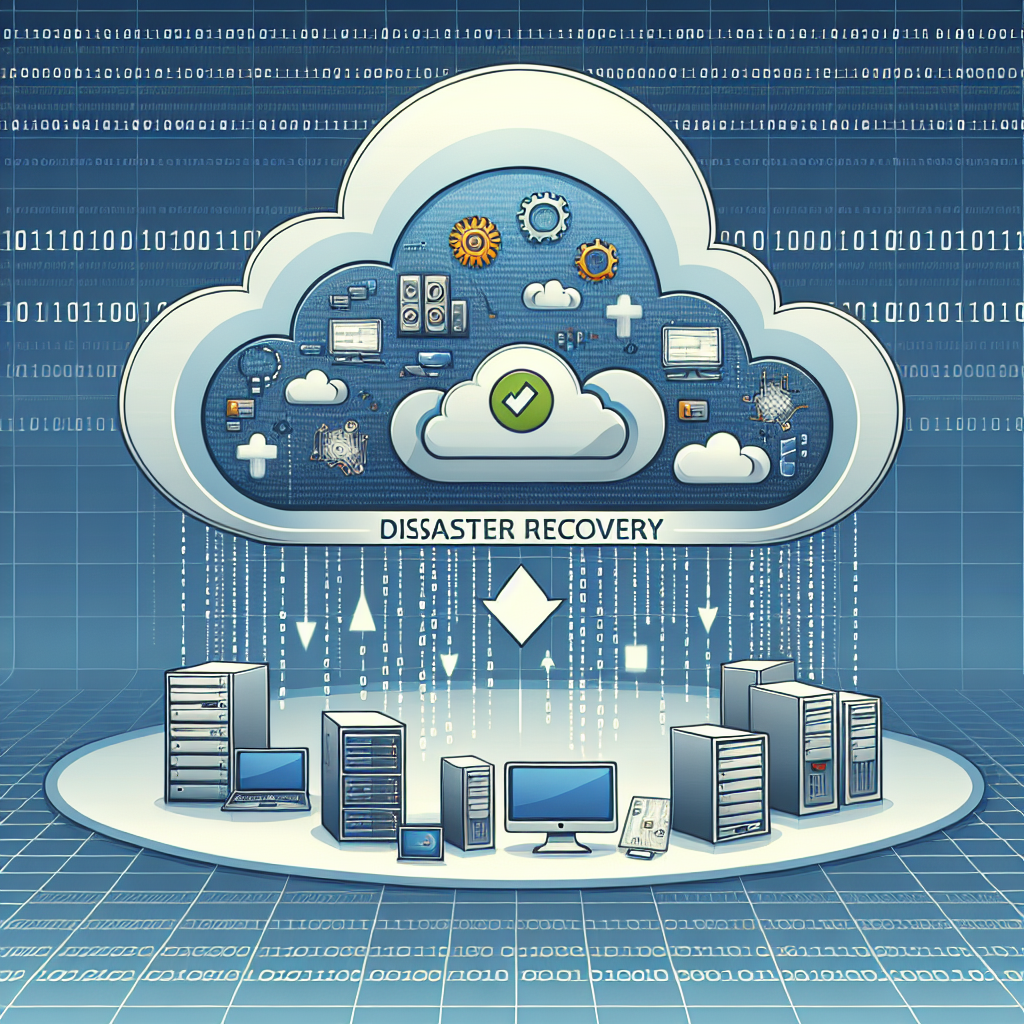Your cart is currently empty!
Tag: Resilience

Preparing for the Worst: The Role of Disaster Recovery in Business Resilience
In today’s unpredictable world, businesses face a myriad of risks that could potentially disrupt their operations. From natural disasters like hurricanes and earthquakes to cyber attacks and data breaches, the threats to business continuity are numerous and varied. In order to ensure that they can weather any storm, businesses must have robust disaster recovery plans in place.Disaster recovery is the process of restoring data, systems, and operations in the event of a disaster or disruption. It is a crucial component of business resilience, which refers to an organization’s ability to adapt and bounce back from unexpected events.
There are several key steps that businesses can take to prepare for the worst and enhance their disaster recovery capabilities. Firstly, businesses should conduct a thorough risk assessment to identify potential threats and vulnerabilities. This could involve assessing the likelihood of various disasters occurring, as well as the potential impact they could have on the business.
Once risks have been identified, businesses should develop a comprehensive disaster recovery plan that outlines how they will respond to different scenarios. This plan should include details on how data will be backed up, who will be responsible for managing the recovery process, and what communication protocols will be in place.
It is also important for businesses to regularly test their disaster recovery plan to ensure that it is effective and can be implemented quickly in the event of a real disaster. This could involve running simulations or tabletop exercises to practice the response to different scenarios.
In addition to technical measures, businesses should also consider the human aspect of disaster recovery. This could involve training employees on their roles and responsibilities in the event of a disaster, as well as providing support and guidance to help them cope with the aftermath.
Ultimately, disaster recovery is a critical component of business resilience. By taking proactive steps to prepare for the worst, businesses can ensure that they are able to bounce back from unexpected events and continue operating effectively. With the right planning and preparation, businesses can minimize the impact of disasters and emerge stronger and more resilient in the face of adversity.

Enhancing IT Infrastructure Resilience with Proactive Management Strategies
In today’s fast-paced digital world, having a resilient IT infrastructure is essential for businesses to stay competitive and avoid costly disruptions. With the increasing reliance on technology for day-to-day operations, it is crucial for organizations to proactively manage their IT infrastructure to ensure it can withstand potential threats and challenges.One of the key strategies for enhancing IT infrastructure resilience is proactive management. This involves actively monitoring, maintaining, and optimizing IT systems to prevent issues before they occur. By taking a proactive approach, businesses can minimize downtime, improve performance, and enhance overall efficiency.
There are several proactive management strategies that can help organizations strengthen their IT infrastructure resilience. These include:
1. Regular monitoring and maintenance: Regularly monitoring and maintaining IT systems is essential for identifying potential issues and addressing them before they escalate. By conducting routine checks and updates, businesses can prevent system failures and ensure smooth operation.
2. Implementing redundancy and backup solutions: Having redundant systems and backup solutions in place can help minimize the impact of unexpected events, such as hardware failures or cyberattacks. By having backup systems in place, businesses can quickly recover data and resume operations in the event of a disruption.
3. Conducting regular security audits: Security is a critical aspect of IT infrastructure resilience. Conducting regular security audits can help identify vulnerabilities and weaknesses in the system, allowing organizations to take proactive measures to strengthen their defenses against cyber threats.
4. Disaster recovery planning: Developing a comprehensive disaster recovery plan is essential for businesses to quickly recover from any major disruptions, such as natural disasters or cyberattacks. By having a well-defined plan in place, organizations can minimize downtime and ensure business continuity in the face of adversity.
5. Investing in automation and AI technology: Automation and artificial intelligence (AI) technology can help streamline IT operations and improve efficiency. By automating routine tasks and leveraging AI for predictive maintenance, businesses can proactively manage their IT infrastructure and respond to issues more effectively.
Overall, proactive management strategies are essential for enhancing IT infrastructure resilience and ensuring business continuity. By taking a proactive approach to IT management, organizations can minimize downtime, improve performance, and better protect their systems against potential threats. Investing in proactive management strategies can ultimately help businesses stay ahead of the curve and thrive in today’s digital landscape.

Ensuring Resilience: The Role of Business Continuity in Risk Management
In today’s fast-paced and unpredictable business environment, ensuring resilience is crucial for the longevity and success of any organization. One key aspect of resilience is the ability to effectively manage risks that could disrupt operations and threaten the continuity of the business. This is where business continuity planning plays a critical role in risk management.Business continuity planning involves identifying potential risks, developing strategies to mitigate those risks, and creating a plan to ensure that essential business functions can continue in the event of a disruption. By proactively addressing potential threats, organizations can minimize the impact of disruptions and quickly recover from any setbacks.
One of the key benefits of business continuity planning is that it helps organizations identify vulnerabilities in their operations and take steps to strengthen their resilience. By conducting a thorough risk assessment and developing a comprehensive business continuity plan, organizations can better prepare for a wide range of potential threats, including natural disasters, cyberattacks, supply chain disruptions, and other unexpected events.
In addition to minimizing the impact of disruptions, business continuity planning can also help organizations maintain customer trust and loyalty. By demonstrating a commitment to resilience and preparedness, organizations can instill confidence in their customers, employees, and other stakeholders that they will be able to weather any storm and continue to deliver products and services without interruption.
Furthermore, business continuity planning can also help organizations comply with regulatory requirements and industry standards. Many industries have specific regulations that require organizations to have a business continuity plan in place to ensure the safety and security of their operations. By implementing a robust business continuity plan, organizations can demonstrate their commitment to compliance and avoid potential penalties for non-compliance.
Ultimately, business continuity planning is an essential component of a comprehensive risk management strategy. By proactively identifying and addressing potential risks, organizations can enhance their resilience, protect their operations, and maintain their competitive advantage in an increasingly uncertain business landscape. Investing in business continuity planning is not only a smart business decision but also a critical step towards ensuring the long-term success and sustainability of any organization.

Building Resilience: How Disaster Recovery Plans Can Help Businesses Weather Any Storm
In today’s fast-paced and unpredictable business landscape, it is crucial for companies to have a solid disaster recovery plan in place. Natural disasters, cyber attacks, and other unexpected events can wreak havoc on a business’s operations, leading to significant financial losses and damage to its reputation. Building resilience through a comprehensive disaster recovery plan can help businesses weather any storm and emerge stronger on the other side.One of the key benefits of having a disaster recovery plan is that it allows businesses to quickly respond to and recover from unexpected events. By outlining the steps that need to be taken in the event of a disaster, companies can minimize downtime and get back up and running as soon as possible. This can help prevent significant financial losses and ensure that the business is able to continue operating smoothly.
In addition to minimizing downtime, a disaster recovery plan can also help businesses protect their data and information. In today’s digital age, data is often one of a company’s most valuable assets. By having a plan in place for backing up and securing data, businesses can ensure that they are able to recover and access critical information in the event of a disaster. This can help prevent data loss and minimize the impact of a disaster on the business’s operations.
Furthermore, having a disaster recovery plan in place can help businesses maintain their reputation and credibility in the eyes of customers and stakeholders. By demonstrating that they are prepared for unexpected events and have a plan in place to mitigate their impact, businesses can build trust and confidence with their clients and partners. This can help protect the business’s brand and ensure that it is able to continue operating successfully in the aftermath of a disaster.
Overall, building resilience through a comprehensive disaster recovery plan is essential for businesses looking to thrive in today’s unpredictable business environment. By taking proactive steps to prepare for unexpected events, companies can minimize downtime, protect their data, and maintain their reputation in the face of adversity. Investing in a disaster recovery plan is a critical step for businesses looking to weather any storm and emerge stronger on the other side.

Building Resilience: Key Components of a Strong Business Continuity Plan
In today’s rapidly changing and unpredictable business environment, it is more important than ever for companies to have a strong business continuity plan in place. A business continuity plan is a proactive strategy that helps organizations prepare for and respond to potential disruptions, such as natural disasters, cyber attacks, or other unforeseen events that could threaten the operations of the business.Building resilience is a key component of a strong business continuity plan. Resilience refers to the ability of an organization to adapt, recover, and thrive in the face of adversity. By building resilience into their business continuity plan, companies can better prepare for and respond to disruptions, minimize the impact on their operations, and ensure the long-term sustainability of their business.
There are several key components of a strong business continuity plan that can help companies build resilience and ensure their ability to withstand and recover from disruptions. These include:
1. Risk assessment and mitigation: The first step in building resilience is to identify and assess potential risks that could impact the business. This includes conducting a thorough risk assessment to identify vulnerabilities and develop strategies to mitigate these risks. By understanding the potential threats to their operations, companies can better prepare for and respond to disruptions when they occur.
2. Business impact analysis: A business impact analysis helps companies understand the potential impact of disruptions on their operations, including financial losses, reputational damage, and regulatory compliance issues. By conducting a business impact analysis, companies can prioritize their response efforts and allocate resources more effectively to minimize the impact of disruptions.
3. Continuity planning: Developing a comprehensive continuity plan is essential for building resilience. This plan should outline the steps that the company will take to ensure the continued operation of critical business functions in the event of a disruption. This may include establishing backup systems, implementing redundant processes, and developing communication protocols to keep employees, customers, and stakeholders informed during a crisis.
4. Training and testing: Building resilience also requires ongoing training and testing of the business continuity plan. This helps ensure that employees are prepared to respond effectively to disruptions and that the plan is up-to-date and effective. Regular training exercises and drills can help identify gaps in the plan and provide opportunities for improvement.
5. Communication and coordination: Effective communication is essential for building resilience. Companies should establish clear communication protocols to ensure that employees, customers, and stakeholders receive timely and accurate information during a disruption. Coordination with external partners, such as suppliers, vendors, and regulatory agencies, is also important to ensure a coordinated response to a crisis.
By incorporating these key components into their business continuity plan, companies can build resilience and enhance their ability to adapt, recover, and thrive in the face of adversity. Building resilience is not only essential for ensuring the long-term sustainability of a business but also for protecting its reputation, brand, and relationships with customers and stakeholders. Investing in a strong business continuity plan that prioritizes resilience can help companies navigate and overcome the challenges of an increasingly complex and unpredictable business environment.

Disaster Recovery in the Cloud: Leveraging Technology for Improved Resilience
In today’s digital age, businesses rely heavily on technology to operate efficiently and effectively. However, with the increasing frequency and severity of natural disasters, it has become more important than ever for organizations to have a solid disaster recovery plan in place to ensure business continuity in the event of a disaster.One of the most effective ways to ensure that your business is prepared for a disaster is to leverage cloud technology for disaster recovery. By utilizing the cloud, businesses can store and backup their data in a secure and easily accessible location, making it easier to recover in the event of a disaster.
Cloud-based disaster recovery offers several key advantages over traditional disaster recovery methods. One of the main benefits is the flexibility and scalability it provides. With cloud-based disaster recovery, businesses can easily scale their storage and backup capabilities as needed, without the need for costly hardware upgrades or additional infrastructure.
Additionally, cloud-based disaster recovery offers improved resilience and reliability. Cloud service providers typically have multiple data centers located in different geographic regions, ensuring that data is securely backed up and accessible even in the event of a regional disaster.
Another key advantage of leveraging cloud technology for disaster recovery is the cost savings it provides. Traditional disaster recovery solutions often require businesses to invest in expensive hardware, software, and maintenance costs. With cloud-based disaster recovery, businesses can pay for only the storage and backup services they need, reducing overall costs and providing a more cost-effective solution.
Furthermore, cloud-based disaster recovery offers increased automation and efficiency. With cloud-based solutions, businesses can automate the backup and recovery process, reducing the risk of human error and ensuring that critical data is always protected and accessible.
In conclusion, disaster recovery in the cloud offers businesses a more reliable, cost-effective, and efficient solution for ensuring business continuity in the event of a disaster. By leveraging cloud technology for disaster recovery, businesses can improve their resilience and readiness to respond to unforeseen events, ultimately protecting their data and ensuring the continuity of their operations.

Investing in Resilience: The ROI of Implementing Business Continuity Plans
In today’s unpredictable world, businesses are constantly faced with a myriad of risks that can impact their operations. From natural disasters to cyber attacks, the threat landscape is ever-evolving, making it imperative for organizations to have robust business continuity plans in place. Investing in resilience through the implementation of such plans can not only help businesses weather the storm in times of crisis but also provide a significant return on investment (ROI) in the long run.Business continuity planning involves identifying potential risks, assessing their potential impact on the organization, and developing strategies to mitigate these risks and ensure business continuity. By investing in resilience, businesses can minimize the potential financial losses associated with disruptions to operations and maintain a competitive edge in the market.
One of the key benefits of implementing a business continuity plan is the ability to reduce downtime in the event of a crisis. Downtime can be costly for businesses, resulting in lost revenue, damaged reputation, and decreased productivity. By having a plan in place to quickly resume operations after a disruption, businesses can minimize the impact on their bottom line and maintain customer trust.
Additionally, investing in resilience can help businesses comply with regulatory requirements and industry standards. Many industries have specific regulations in place that require organizations to have business continuity plans to protect critical operations and sensitive data. By implementing a robust plan, businesses can ensure compliance with these requirements and avoid costly fines and penalties.
Furthermore, investing in resilience can also enhance an organization’s reputation and brand value. Customers and partners are more likely to trust and do business with companies that have a proven track record of resilience and the ability to bounce back from adversity. By demonstrating a commitment to business continuity, organizations can differentiate themselves from competitors and attract new opportunities for growth and expansion.
In conclusion, investing in resilience through the implementation of business continuity plans is essential for the long-term success and sustainability of businesses. By proactively identifying and mitigating risks, organizations can minimize the impact of disruptions, reduce downtime, comply with regulatory requirements, and enhance their reputation in the market. Ultimately, the ROI of implementing business continuity plans far outweighs the initial investment and can provide businesses with a competitive advantage in an increasingly uncertain world.

Disaster Recovery Best Practices: Ensuring Business Resilience in Times of Crisis
Disasters can strike at any time, from natural disasters like hurricanes and earthquakes to cyberattacks and data breaches. No matter the cause, the impact on businesses can be devastating if they are not prepared. That’s why having a solid disaster recovery plan in place is essential for ensuring business resilience in times of crisis.Disaster recovery best practices involve a combination of proactive planning, regular testing, and quick response strategies to minimize downtime and ensure business continuity. Here are some key best practices to consider when developing a disaster recovery plan for your business:
1. Conduct a risk assessment: Before creating a disaster recovery plan, it’s important to assess the potential risks that could impact your business. This includes identifying potential threats, vulnerabilities, and the potential impact they could have on your operations. By understanding the risks, you can develop a plan that addresses the specific challenges your business may face.
2. Develop a comprehensive plan: A disaster recovery plan should outline the steps that need to be taken in the event of a disaster, including how to protect critical data and systems, how to communicate with employees and stakeholders, and how to implement recovery strategies. The plan should be comprehensive and include detailed procedures for responding to different types of disasters.
3. Regularly back up data: Data is the lifeblood of any business, so it’s crucial to regularly back up critical data to ensure it can be recovered in the event of a disaster. This includes backing up data both on-site and off-site to protect against physical damage and cyber threats.
4. Test your plan: Regularly testing your disaster recovery plan is essential to ensure it will work when needed. Conducting regular drills and simulations can help identify any gaps or weaknesses in the plan and allow you to make necessary adjustments before a real disaster strikes.
5. Communicate with stakeholders: In the event of a disaster, clear communication is key to ensuring the safety of employees and stakeholders, as well as minimizing confusion and uncertainty. Develop a communication plan that outlines how information will be shared, who will be responsible for communication, and how updates will be provided.
6. Consider cloud-based solutions: Cloud-based disaster recovery solutions can provide an added layer of protection for your data and systems. By storing critical data and applications in the cloud, businesses can quickly recover and resume operations in the event of a disaster.
7. Review and update your plan regularly: Disaster recovery plans should be living documents that are regularly reviewed and updated to reflect changes in technology, business operations, and potential threats. By keeping your plan current, you can ensure that it remains effective in protecting your business in times of crisis.
In conclusion, disaster recovery best practices are essential for ensuring business resilience in times of crisis. By following these key practices and developing a comprehensive disaster recovery plan, businesses can minimize downtime, protect critical data, and ensure continuity of operations in the face of disaster. Remember, it’s not a matter of if a disaster will strike, but when – so it’s crucial to be prepared.

From Crisis to Recovery: The Role of Business Continuity Planning in Ensuring Resilience
In today’s fast-paced and unpredictable business environment, organizations face a multitude of risks that can disrupt their operations and jeopardize their bottom line. From natural disasters and cyber-attacks to supply chain disruptions and pandemics, the threats to business continuity are numerous and varied. In the face of such challenges, it is crucial for companies to have a robust business continuity plan in place to ensure resilience and quick recovery in times of crisis.Business continuity planning (BCP) is a systematic approach to identifying and mitigating risks, as well as developing strategies to maintain essential business functions during and after a crisis. It involves assessing potential threats, developing response and recovery plans, and regularly testing and updating these plans to ensure they remain effective.
One of the key roles of BCP is to enhance an organization’s resilience by helping it to anticipate, prepare for, and respond to disruptions in a timely and effective manner. By identifying critical business processes, resources, and dependencies, companies can prioritize their response efforts and allocate resources more efficiently during a crisis. This proactive approach not only minimizes the impact of disruptions but also helps organizations to recover more quickly and resume normal operations.
Moreover, BCP can also help companies to protect their reputation and maintain customer trust during a crisis. By having clear communication strategies in place and keeping stakeholders informed about the situation, organizations can demonstrate their commitment to transparency and accountability, which can help to mitigate the negative impact of a crisis on their brand and reputation.
In addition, BCP can also help companies to comply with regulatory requirements and industry standards, as well as enhance their overall risk management practices. By identifying potential risks and developing mitigation strategies, organizations can reduce their exposure to threats and ensure compliance with relevant laws and regulations.
Overall, business continuity planning plays a critical role in ensuring resilience and enabling organizations to navigate through crises and emerge stronger on the other side. By investing in BCP, companies can better protect their operations, employees, and stakeholders, and position themselves for long-term success in an increasingly uncertain world.

Disaster Recovery Best Practices: Ensuring Resilience in the Face of Adversity
Disasters can strike at any time, and businesses need to be prepared to handle the aftermath in order to ensure resilience and continuity. Disaster recovery planning is essential for organizations to minimize downtime, protect critical data, and resume operations quickly after a disaster. By following best practices, businesses can mitigate the impact of disasters and ensure they are prepared to face adversity head-on.One of the first steps in disaster recovery planning is to conduct a risk assessment to identify potential threats and vulnerabilities that could disrupt business operations. This involves evaluating the likelihood of various disasters, such as natural disasters, cyber attacks, and equipment failures, and assessing the potential impact on the organization. By understanding the risks, businesses can develop a comprehensive disaster recovery plan that addresses their specific needs and priorities.
Another key best practice is to regularly back up critical data and systems to ensure they can be quickly restored in the event of a disaster. Data backups should be stored offsite in a secure location to prevent loss in the event of a physical disaster, such as a fire or flood. It is also important to test backups regularly to ensure they are functioning properly and can be restored quickly when needed.
Businesses should also establish clear communication and incident response procedures to ensure a coordinated and efficient response to a disaster. This includes designating key personnel responsible for managing the recovery process, establishing communication channels to keep employees informed, and coordinating with external partners, such as vendors and customers, to minimize disruptions to the business.
In addition, businesses should consider implementing redundant systems and infrastructure to minimize the impact of a disaster on critical operations. This may include deploying backup servers, establishing secondary data centers, and implementing failover mechanisms to ensure continuous operation in the event of a system failure.
Regular testing and training are also essential components of disaster recovery planning. Businesses should conduct regular drills and exercises to test the effectiveness of their disaster recovery plan and ensure employees are familiar with their roles and responsibilities in the event of a disaster. This will help identify gaps in the plan and provide an opportunity to make necessary adjustments to improve resilience.
By following these best practices, businesses can ensure they are prepared to handle the challenges of a disaster and minimize the impact on their operations. Disaster recovery planning is an ongoing process that requires continuous evaluation and improvement to adapt to changing threats and vulnerabilities. By investing in disaster recovery preparedness, businesses can protect their critical assets and ensure resilience in the face of adversity.
